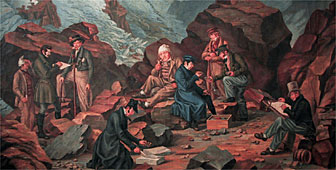
Glacier experiments helped define ice age theory

Experiments carried out under extreme conditions on the Unteraar Glacier more than a century ago helped define the theory of the ice age, while also helping scientists chart the movement of glaciers.
In 1827, Franz Joseph Hugi of Solothurn built a primitive hut on the glacier, then pounded in a series of stakes and chiselled marks onto the rocks, becoming the first to measure glacial movement.
It was an important development, supporting theories of some European scholars and confirming what mountain dwellers already knew — that glaciers were not static, they could advance and retreat great distances.
From scientists to peasants, many 17th and 18th century thinkers contributed to the development of the ice age theory. But it wasn’t until the first half of the 19th century that the theory was properly defined and the movement of glaciers understood, thanks in no small part to the experiments carried out under primitive conditions on the Unteraar Glacier.
Hugi’s successor was Louis Agassiz, a respected zoologist and palaeontologist from Neuchatel, who took the findings a step further when he claimed in 1837 that glaciers had once covered most of Eurasia.
Flood or glaciers?
His theory caused an uproar in the scientific community. But what, if not glaciers, Agassiz argued, could have left the giant boulders found in unlikely spots around the continent? The theory challenged a popular belief of the day, that the biblical “deluge” had left the boulders.
Agassiz set off for the Unteraar Glacier to prove his theory. Over the next five summers, he and his team holed up in a provisional shelter between two boulders dubbed the Hôtel des Neuchâtelois. There they made the first systematic glacial investigations.
From thermometers and hygrometers to weigh scales, and a large iron auger to punch holes under the glacier’s surface, Agassiz was equipped with a range of supplies.
The auger was attached to a winch, which meant it could be used as a battering ram. It enabled Agassiz, after several weeks of boring, to reach a depth of 50 metres – still a long way from the glacial bed – but deep enough to prove that glaciers were thicker than assumed at the time.
Agassiz conducted tests and made observations of glacial movement and composition, and measured ice temperature and atmospheric humidity.
Inside the glacier
On one occasion, he descended into the icy depths himself, following the vertical trail of a crevasse.
When he wasn’t on the glacier, the scientist travelled extensively across Europe, and in London, he won over some of Britain’s leading scholars.
A number of them made their way to the “Hôtel des Neuchâtelois” to watch Agassiz at work. Among them was the Scottish physicist, James David Forbes.
Forbes, already recognised for his groundbreaking research on heat, was travelling across the Alps in 1841 to study glaciers when he visited the Unteraar.
A dispute broke out between the two men over the discovery of certain glacial principles and hypotheses on movement. But it didn’t matter. As far as the scientific community was concerned, the pendulum had swung back in favour of the flood theory.
The assumption that ice had once covered large parts of the earth was, by 1850, officially dismissed as an aberration.
By this time, Agassiz had emigrated to the United States, where he found evidence showing that glaciers had covered a larger part of the earth’s surface than even he had assumed.
It would take another quarter century before the ice age theory, this time supported and presented by a Swedish academic, would finally win scientific support.
Since Agassiz abandoned the “Hôtel des Neuchâtelois” in 1845, the Unteraar Glacier has been anything but inactive – it has receded by approximately two kilometres.

In compliance with the JTI standards
More: SWI swissinfo.ch certified by the Journalism Trust Initiative















![The four-metre-long painting "Sonntag der Bergbauern" [Sunday of the Mountain Farmers, 1923-24/26] had to be removed by a crane from the German Chancellery in Berlin for the exhibition in Bern.](https://www.swissinfo.ch/content/wp-content/uploads/sites/13/2025/12/01_Pressebild_KirchnerxKirchner.jpg?ver=a45b19f3)













You can find an overview of ongoing debates with our journalists here . Please join us!
If you want to start a conversation about a topic raised in this article or want to report factual errors, email us at english@swissinfo.ch.